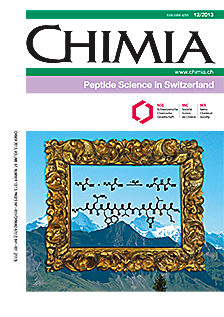A Journey from the Pool of Chiral Synthetic Building Blocks to Cell-Penetrating Peptides, to a Novel Type of Enzyme – and back
DOI:
https://doi.org/10.2533/chimia.2013.844Keywords:
Cell-penetrating peptides, Fosmidomycin, Oligoarginines, Polyhydroxybutyrate, Beta-peptides, Peptidomimetics, Terminal homologation of peptidesAbstract
The roles of polyhydroxy-butyrates/alkanoates (PHB/PHA) in biology, for the preparation of chiral building blocks, and as a source of inspiration for the discovery of ?- and ?-peptides are discussed. The syntheses and structures of ?-peptides are outlined. The prerequisites for mimicking peptide/protein interactions with ?-peptides and two examples are presented. Single terminal ?-amino-acid residues can lead to stabilization of peptides (cf. NTS(8-13)) in plasma. Cell-penetrating ?-L-, ?-D-, mixed ?-L/D- and ?-oligoarginines (OAs) and -oligoprolines, as well as the mechanism(s) of internalization are compared. Recent studies show that infected erythrocytes, parasitic organisms and mycobacteria are entered by OA-derivatives, which have been employed as transporters of the antibiotic fosmidomycin. While ?-peptides are generally enzymatically stable (for days in mammals), a microorganism (S. xenopeptidilytica) with an Ntn enzyme (3-2W4 BapA) was discovered that cleaves only ?-peptides, and that was applied in preparations of (enantiopure) ?-amino acids and ?-peptides.Downloads
Published
2013-12-18
Issue
Section
Scientific Articles
License
Copyright (c) 2013 Swiss Chemical Society

This work is licensed under a Creative Commons Attribution-NonCommercial 4.0 International License.
How to Cite
[1]
Chimia 2013, 67, 844, DOI: 10.2533/chimia.2013.844.







